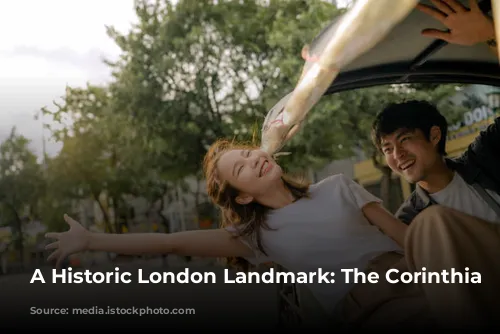The Corinthia Hotel London, a majestic building situated in the heart of London, boasts a rich history dating back to the Victorian era. It stands proudly at the intersection of Northumberland Avenue and Whitehall Place, forming a triangular site between the iconic Trafalgar Square and the Thames Embankment. This prominent location, just a stone’s throw from the Houses of Parliament and government offices, has played a pivotal role in shaping the hotel’s unique story.
From Grand Hotel to Government Hub
Originally opened in 1885 as the Metropole Hotel, the building quickly became a hub of social and political activity. Its proximity to the seat of power attracted dignitaries and celebrities alike, making it a prestigious address for its time. The hotel’s opulent interiors and luxurious amenities were renowned, and it became a popular destination for high-society gatherings and lavish events.
However, the hotel’s role was significantly altered during the 20th century. The outbreak of World War I saw the government requisition the hotel to provide accommodation for government staff. This marked the beginning of a period where the Metropole served as a vital government building, housing various departments and ministries.
During World War II, the hotel was once again requisitioned, this time becoming a vital hub for military operations. It played a critical role in the war effort, serving as a base for crucial intelligence operations and planning for Operation Overlord, the Allied invasion of Normandy.
A Legacy of Transformation
After the war, the government purchased the hotel from the Gordon Hotels company and incorporated it into the Crown Estate portfolio. The Ministry of Defence took control, using the building as a central hub for its operations. For decades, the Metropole housed various government departments, including the Air Ministry and the Defence Intelligence Staff.
In the latter half of the 20th century, the building continued to serve as a government building, undergoing several refurbishments and hosting numerous important events. The hotel’s iconic mirrored ballroom was often used for press conferences and other high-profile gatherings.
A Return to Hospitality
In 2007, after years of government ownership, the Metropole Building was sold to a consortium led by Malta’s IHI plc. After extensive renovations and restoration, the building reopened in 2011 as the Corinthia Hotel, a luxurious blend of hotel and residential accommodations. The hotel’s transformation into a modern, sophisticated destination has breathed new life into this historic landmark.
A Place of Cultural Significance
The Corinthia Hotel has also become a popular location for film and television productions. The hotel’s iconic architecture and grand interiors have been featured in several major films, including the James Bond movie “Skyfall” and the thriller “Red Sparrow.” These cinematic appearances have further solidified the hotel’s position as a prominent landmark in London’s cultural landscape.
A Lasting Legacy
From its grand beginnings as the Metropole Hotel to its transformation into the contemporary Corinthia Hotel, this landmark building has witnessed a century of history and change. Its location at the heart of London’s power center has ensured its place as a prominent fixture in the city’s landscape. The Corinthia Hotel continues to be a vibrant destination for travelers and locals alike, offering a unique blend of historical significance and contemporary luxury.












